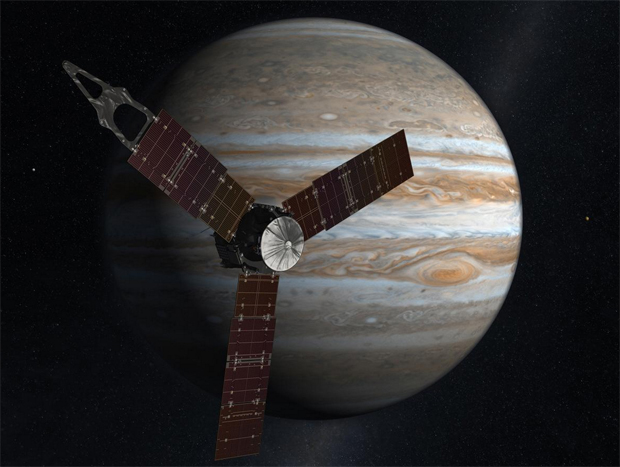Juno heads back toward Jupiter, ready for science
After braking into a highly elliptical path around Jupiter on July 4, NASA's Juno spacecraft finally reached the high-point of its initial 53.4-day orbit Sunday, setting up a long plunge back toward its quarry and an Aug. 27 close encounter with all of its instruments up and running.
"We're very pleased about the state of the spacecraft and the state of the instruments, they all look really good," Rick Nybakken, Juno project manager at the Jet Propulsion Laboratory, said in an interview.
Juno passed within a few thousand miles of Jupiter's cloud tops during the Jupiter orbit insertion -- JOI -- rocket firing on July 4 and on Sunday, at 3:41 p.m. EDT (GMT-4), the spacecraft was expected to turn the corner, passing through the high point of the orbit, or apojove, at a distance of some 5 million miles from the giant planet.
On Aug. 27, Juno will pass about 2,600 miles above the top of the atmosphere, a point known as perijove 1, before heading back out again. And this time around, all of its instruments will be turned on and collecting data about Jupiter's deep interior, its powerful magnetic field, the radiation environment and the hidden structure of its turbulent atmosphere.
During the JOI maneuver, Juno's instruments were turned off, allowing the spacecraft's flight computer to devote all its resources to carrying out the make-or-break rocket firing deep in Jupiter's magnetic field, which traps and accelerates charged particles from the sun to generate intense radiation.
Even with the flight computer shielded inside a titanium vault, Nybakken said: "We did see some evidence of radiation in the form of single-bit errors in the spaceflight computer."
"We saw 62 single-bit errors, all of them corrected," he said in an interview Friday. "Most of them, I think 38, were near the front of the burn and then we got the remaining (errors) near the end of the burn. Which is right where we expected to see radiation peaks."
Juno came through the orbit insertion maneuver in near flawless fashion. Two days later, engineers began powering up and checking out its suite of science instruments.
"Everything is as expected," Nybakken said. The instruments "all look really good, and they're ready for perijove 1, our first pass with instruments on, Aug. 27."
Juno's camera -- JunoCam -- also was shut down during orbit insertion, but it is back in action, taking long-distance shots that will be combined into a so-called "marble movie."
"Obviously, a lot of the shots are going to be when Jupiter is the size of a marble, but what I'm looking forward to, personally, is when we (fly by) the planet and it gets really big," Nybakken said. "That's what the camera's for, it's for those close-up shots."
Juno will fly through two 53-day capture orbits before a critical Oct. 19 rocket firing that will drastically lower the high point of the orbit and put the spacecraft in its planned 14-day science orbit, repeatedly passing between 2,600 and 4,900 miles above Jupiter's cloud tops.
The planned science is optimized for the 14-day science orbit, and the upcoming Aug. 27 encounter will serve as a valuable test run for the spacecraft's instruments and subsystems.
"Of course, our expectation is we'll probably get very good science," Nybakken said of the perijove 1 encounter. "In that way, it's icing on the cake. It could very well turn out that this ends up the equivalent of a full science pass."
More important, the run in and around Jupiter will give engineers a chance to "evaluate everything top to bottom to make sure we're ready to pull the trigger on the fourth main engine burn on Oct. 19," Nybakken said.
"Once you pull that trigger, you're in a 14-day orbit, the radiation clock is ticking that much faster, so we want to use JOI data and PJ-1 data to make the most informed decision we can about our readiness to commit to the 14-day orbit. So far so good, JOI was very successful."
Launched Aug. 5, 2011, atop a United Launch Alliance Atlas 5 rocket, the solar-powered Juno picked up a gravitational boost during a close flyby of Earth in October 2013, putting the craft on a trajectory to intersect Jupiter.
Finally, on July 4, traveling at 130,000 mph relative to Jupiter, Juno's main engine ignited and burned for 35 minutes as planned, slowing the craft by about 1,200 mph. That was just enough to bend the trajectory into the desired capture orbit.
Radiation has been a major concern from the beginning, and it is expected to limit Juno's useful life to about 20 months, or 37 orbits. As such, "it's something we're watching," Nybakken said.
"We will be characterizing and watching every environmental effect we see on the spacecraft even if it has no impact," he said. "That's why we're there. That's what makes the next pass on Aug. 27 so exciting. Not only do we get to see everything with the spacecraft, but we'll see it with the instruments as well."
Jupiter, Mars and Saturn are currently visible to the unaided eye in the evening sky. Five satellites and two rovers are operating on reddish Mars, NASA's Cassini spacecraft is orbiting Saturn and Juno is about to start collecting science data at Jupiter. For Nybakken, the nightly view puts all the work that went into the mission into perspective.
"To borrow from my son's vernacular, it's way cool," he said. "It's one thing to see all the data, and viewgraphs, and the reports with everybody in the room. It's another thing to look up in the sky at night and find Jupiter and realize that's where we are. Now that's mind blowing."

